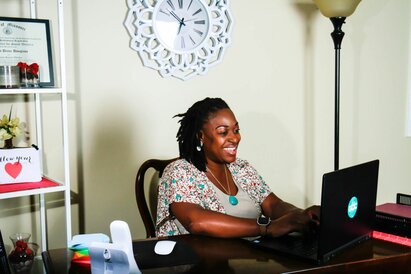How Telehealth Video Therapy Improves Access


Published November 10, 2021

“Nothing is absolute. Everything changes, everything moves, everything revolves, everything flies and goes away.” – Frida Kahlo
Over the last year, most of us in the mental health profession have made the pivot to telehealth therapy—and many of us love this new arrangement. We’re often cozy in our own homes, and we get to see our clients in their homes too. This can have a deepening effect on the therapeutic relationship right away.
It’s intimate before we even say anything. Maybe there are cats slinking around in the background or children playing in the next room. We might notice our client’s poster on the wall. We get to see them where they (hopefully) feel safe. But what about the clients who are on video calls all day for work, right up until the moment that they log on to therapy? How can we make sure to differentiate the work we’re about to do together from just another meeting?
Therapy should be practical. We should aim to be supportive of the client right where they are, and help them to feel better-resourced when they head back out to their life. But therapy is also a call to soul work. It’s equally important for clients to be in touch with their inner world, and their most vulnerable selves—with the unspoken. For this reason, we should think about some indicators that our telehealth therapy session isn’t just another meeting. It’s a chance to start your day over or get resources and clarity, or just to have someone in your corner who’s eager to listen.
One of the simplest and most effective things clinicians can do to help this is to say something like, “This isn’t another video meeting. You can sit back, close your eyes, or lie down. You can walk around a bit. You can take the laptop outside to sit in the sun. Let’s take advantage of the freedom and see if you have any wishes or desires we can accomodate right now.” You can set the boundaries and make the suggestions that feel appropriate for your practice and your clients, but in my experience, it’s been worth taking a moment for this small adjustment.
I’ve had clients whose eyes light up when I make this suggestion. I’ve found that by beginning my telehealth therapy sessions this way, we’re able to head into our session together with a fresh feeling. This demonstrates real-time getting in touch with your needs, builds a little bond between you and your client, and it differentiates the time as special time. All of these are excellent set-ups for further growth in the rest of the session. This mobility of telehealth therapy has also meant that the number of no-shows I get has shrunk down to almost nothing these days.
I’ve appreciated that my video-based practice has allowed me to do some terrific things, such as accompany one of my clients who had been dealing with infertility right up to—and even through—the birth of her child. Ordinarily, there would be a gap in our sessions for her physical recovery. Now that I see her via telehealth, she’ll be able to roll her head over on the pillow, hit “join meeting” and nurse her newborn— all with me next to her. I can be with her on the first day of her baby’s life if she wishes.
My telehealth sessions with this client also offer more than simply an assessment for early intervention for postpartum depression or psychosis, though it can certainly be these too. This client also has an immediate sense of someone being in her corner. For now at least, I may be the only person who is more interested in her than in her baby. For a new mother, telehealth therapy offers more accessible care in a time where they need such support.
When I was in my twenties, I started weekly psychotherapy with my own therapist. This was the greatest gift of my life, and I gave it to myself. I earned money from my job and I spent it getting more free through this funny, strange, intimate agreement to show up every week and speak about what was really going on inside of me. It allowed me to take leaps that I wouldn’t have been able to take without support, and to make a life I deeply love.
Her office and its atmosphere were part of our work, in a way—the paintings, the rug, the chairs, the windows, the books, her view. It was all a little spell of safety. No one can reach us here. We are in the land of reverie. And I would feel like, Now I can say anything. I also began to think about the journey to and from the therapy office as a second session, a time when I was detaching from my ordinary life and moving closer and closer to my inner world.
Telehealth therapy is quite different from the second-session journey from home to a quiet, safe office. We meet on video calls and talk from our homes or cars. I’m not a traditionalist, and I like this new way of meeting. I also think we can use this idea of making our telehealth therapy calls more special as a metaphor of the second session.
We can use it as a reminder to help people with the journeying inward when we’re on a telehealth call together. We can create a ritual, like ringing a bell, speaking an intention together, or making an explicit invitation to ground into some stillness before we work. Whatever ritual you choose has to be true to your approach as a therapist, so it’s worth thinking about more deeply to find what would work best for you and your clients.
Another thing I’ve noticed in my own practice is that my clients seem to appreciate me staying essentially in the same spot. When I appear on their screen in my office, in my usual chair, in front of the same painting of the sloth and the southern star constellation that they always see, it sends a signal to them.
They get a non-verbal indicator that this isn’t a slide presentation or another meeting of tiny faces in a grid. I’m here, ready to be present with a vulnerable, intimate part of themselves. I’ve found that it might be helpful for my clients to visualize that I’m always there, in my office, in front of my painting—even when the screen goes dark at the end of the session.
When the pandemic hit and I first began to do telehealth therapy with my clients, I worried about interruptions. I worried about my clients not having the privacy that they needed, or the confidence that they wouldn’t be overheard so they could explore freely. This is important for us as clinicians to think about and address in our sessions, and in my experience, asking about it can start some interesting conversations about a client’s home life.
But I think that it also turns out that some interruptions might be put to very good use in therapy. They might show us something about our client’s home life that we would not ordinarily see. The way they speak to their children or their spouse, or the way they treat their pet.
Like so many things in therapy, it’s very difficult to say at the outset what will be important or what will be useful to the work that you’re doing together. That’s why as we all move forward with telehealth therapy, it’ll be important to consider the boundaries that shelter time for our clients, and to think about any interruptions might tell us, and how we can use them to offer more informed care.

Elizabeth Sullivan is a psychotherapist in private practice, specializing in feminist psychotherapy. She was educated at the California Institute for Integral Studies, which specializes in an East West approach to mental health. She trained at the Rita da Cascia program at UCSF, which specialized in mental health for women and children with HIV. She also studied at the San Francisco Center for Psychoanalysis, and did a Fellowship year at the Palo Alto Psychoanalytic Psychotherapy Training Program (PAPPTP). She has served as the editor of Psyched Magazine, and as a weekly columnist for advice to parents called “Dear Ms. Shrink”. She is currently writing a longer piece about her mentor, Dr. Kim Chernin, who died in 2020. She is on twitter @Wrldwdetherapy.
Proudly made in Santa Monica, CA © 2025 SimplePractice, LLC
Proudly made in Santa Monica, CA © 2025
SimplePractice, LLC